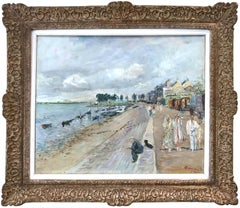Lucien Adrion On Sale
Recent Sales
1930s Post-Impressionist Landscape Paintings
Canvas, Oil
Lucien Adrion for sale on 1stDibs
Lucien Adrion was born May 25, 1889, in Strasbourg, France. He was a French post-Impressionist painter, draftsman and printmaker known for his depictions of the French countryside and beaches, as well as Parisian life including landscape, still life, figure and landmarks paintings. He began his initial studies in Strasbourg as a technical draughtsman. In 1907, at the age of 18, he left his hometown Strasbourg and traveled to Paris, where he found employment in a large drafting company to work as a fashion illustrator. Adrion changed his mind upon arrival and rather than working for a large company, he decided to peruse his artistic career by traveling to London, Munich and Frankfurt. As the World War broke out, he had to go to Berlin, where he studied as an engraver with Hermann Struck, who was also the teacher of Marc Chagall. He remained in Berlin until the war ended and after the demobilization, he went on to study engraving under Franz Ritter von Struck, who was Marc Chagall's teacher as well. Adrion returned to his hometown in France in 1919, and then eventually moved to Paris, where he took a studio in Montparnasse of Paris and allied himself primarily with the young Eastern European painters such as Chaïm Soutine, Pinchus Krémègne, and Michel Kikoïne to operate. In 1921, Adrion had his first solo exhibition at the Galerie Chéron and then in 1926, at the age of 37, he had his first major exhibition at the Salon des Indépendants, where later on, he exhibited regularly. In 1940, he exhibited at the Salon d'Automne and the following year at the Salon des Tuileries where he exhibited several landscapes. As an engraver, watercolorist and painter from the French school, he took a variety of external scenes as subjects for his work, showing a particular fondness for the picturesque aspects of the Parisian landscape, beach scenes,and horse races. Throughout his career, Adrion continued to exhibit his work at the Salons in Paris, where his paintings were praised for their ability to capture the movement and transience of urban life. He eventually left Paris to settle in Normandy, where he began focusing on beach landscapes subject, with great success because they became very popular as decorative paintings.
A Close Look at post-impressionist Art
In the revolutionary wake of Impressionism, artists like Vincent van Gogh, Georges Seurat, Paul Cézanne and Paul Gauguin advanced the style further while firmly rejecting its limitations. Although the artists now associated with Postimpressionist art did not work as part of a group, they collectively employed an approach to expressing moments in time that was even more abstract than that of the Impressionists, and they shared an interest in moving away from naturalistic depictions to more subjective uses of vivid colors and light in their paintings.
The eighth and final Impressionist exhibition was held in Paris in 1886, and Postimpressionism — also spelled Post-Impressionism — is usually dated between then and 1905. The term “Postimpressionism” was coined by British curator and art critic Roger Fry in 1910 at the “Manet and the Postimpressionists” exhibition in London that connected their practices to the pioneering modernist art of Édouard Manet. Many Postimpressionist artists — most of whom lived in France — utilized thickly applied, vibrant pigments that emphasized the brushstrokes on the canvas.
The Postimpressionist movement’s iconic works of art include van Gogh’s The Starry Night (1889) and Seurat’s A Sunday on La Grande Jatte (1884). Seurat’s approach reflected the experimental spirit of Postimpressionism, as he used Pointillist dots of color that were mixed by the eye of the viewer rather than the hand of the artist. Van Gogh, meanwhile, often based his paintings on observation, yet instilled them with an emotional and personal perspective in which colors and forms did not mirror reality. Alongside Mary Cassatt, Cézanne, Henri Matisse and Gauguin, the Dutch painter was a pupil of Camille Pissarro, the groundbreaking Impressionist artist who boldly organized the first independent painting exhibitions in late-19th-century Paris.
The boundary-expanding work of the Postimpressionist painters, which focused on real-life subject matter and featured a prioritization of geometric forms, would inspire the Nabis, German Expressionism, Cubism and other modern art movements to continue to explore abstraction and challenge expectations for art.
Find a collection of original Postimpressionist paintings, mixed media, prints and other art on 1stDibs.
Finding the Right figurative-paintings for You
Figurative art, as opposed to abstract art, retains features from the observable world in its representational depictions of subject matter. Most commonly, figurative paintings reference and explore the human body, but they can also include landscapes, architecture, plants and animals — all portrayed with realism.
While the oldest figurative art dates back tens of thousands of years to cave wall paintings, figurative works made from observation became especially prominent in the early Renaissance. Artists like Michelangelo, Leonardo da Vinci and other Renaissance masters created naturalistic representations of their subjects.
Pablo Picasso is lauded for laying the foundation for modern figurative art in the 1920s. Although abstracted, this work held a strong connection to representing people and other subjects. Other famous figurative artists include Francis Bacon and Lucian Freud. Figurative art in the 20th century would span such diverse genres as Expressionism, Pop art and Surrealism.
Today, a number of figural artists — such as Sedrick Huckaby, Daisy Patton and Eileen Cooper — are making art that uses the human body as its subject.
Because figurative art represents subjects from the real world, natural colors are common in these paintings. A piece of figurative art can be an exciting starting point for setting a tone and creating a color palette in a room.
Browse an extensive collection of figurative paintings on 1stDibs.
